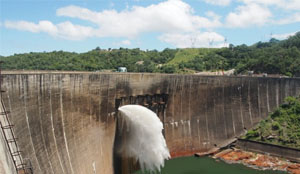 By MAIMBOLWA MULIKELELA –
By MAIMBOLWA MULIKELELA –
THE Kariba Dam rehabilitation works has now pooled a total US$275 million financing from cooperating partners following yesterday’s commitment by the European Union (EU) to provide $100 million.
The Kariba Dam project, which generates 50 per cent of Zambia’s electricity, is expected to be carried out at a total cost of $300 million.
In recent weeks, various donors have unveiled financial support to the dam wall rehabilitation works, with the African Development Bank (AfDB) approving a US$75million concessional loan, the World Bank
provided US$75 million while Sweden added US$75million.
The project financing is being supported by the World Bank, the EU and the governments of Zambia and Zimbabwe, who share the power generated from Lake Kariba in Siavonga.
EU ambassador to Zambia, Gilles Hervio said in a statement yesterday that the Kariba Dam works marked the start of the Union’s long term commitment to improving access to electricity in Zambia.
Mr Hervio said the EU had adopted the 2014 annual action programme for Zambia, this being in line with the 11th EU Development Fund National Indicative Programme for Zambia and for the revised Sixth National Development Plan (SNDP).
Under the programme, the EU was supporting the increased access to clean and reliable energy for the Zambian population.
The project aims to assist the Zambezi River Authority (ZRA) in securing the long-term safety and reliability of the Kariba Dam Hydro-Electric Scheme.
“Over the next six years the EU intends to mobilise 240 million Euros for the sole development of the energy infrastructure, including the extension of the electricity grid to bring electricity to more and
more people in the country,” Mr Hervio said.
In May this year, Finance Minister sounded a financial bail-out call, to prevent the collapse of the dam after an extensive inspection by engineers on the extent of the damage on one of the world’s largest
dams measuring 128 meters in height and 579 in length.
The Kariba Dam was constructed on the Zambezi River between 1956 and 1959 and has been central to energy security and supporting economic development in both Zambia and Zimbabwe.
After 50 years in operation, the dam requires rehabilitation works for its dam foundations, and in refurbishment of the spill-way gates used to regulate the water level of Lake Kariba.






